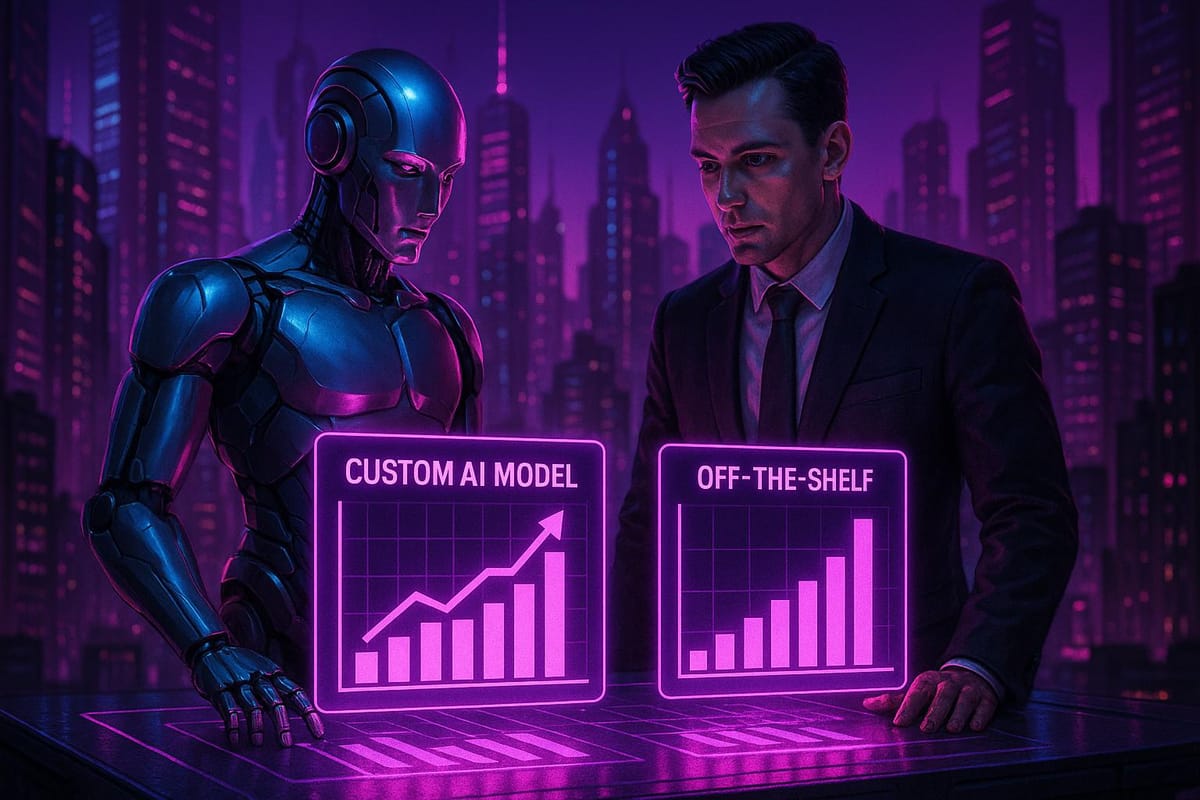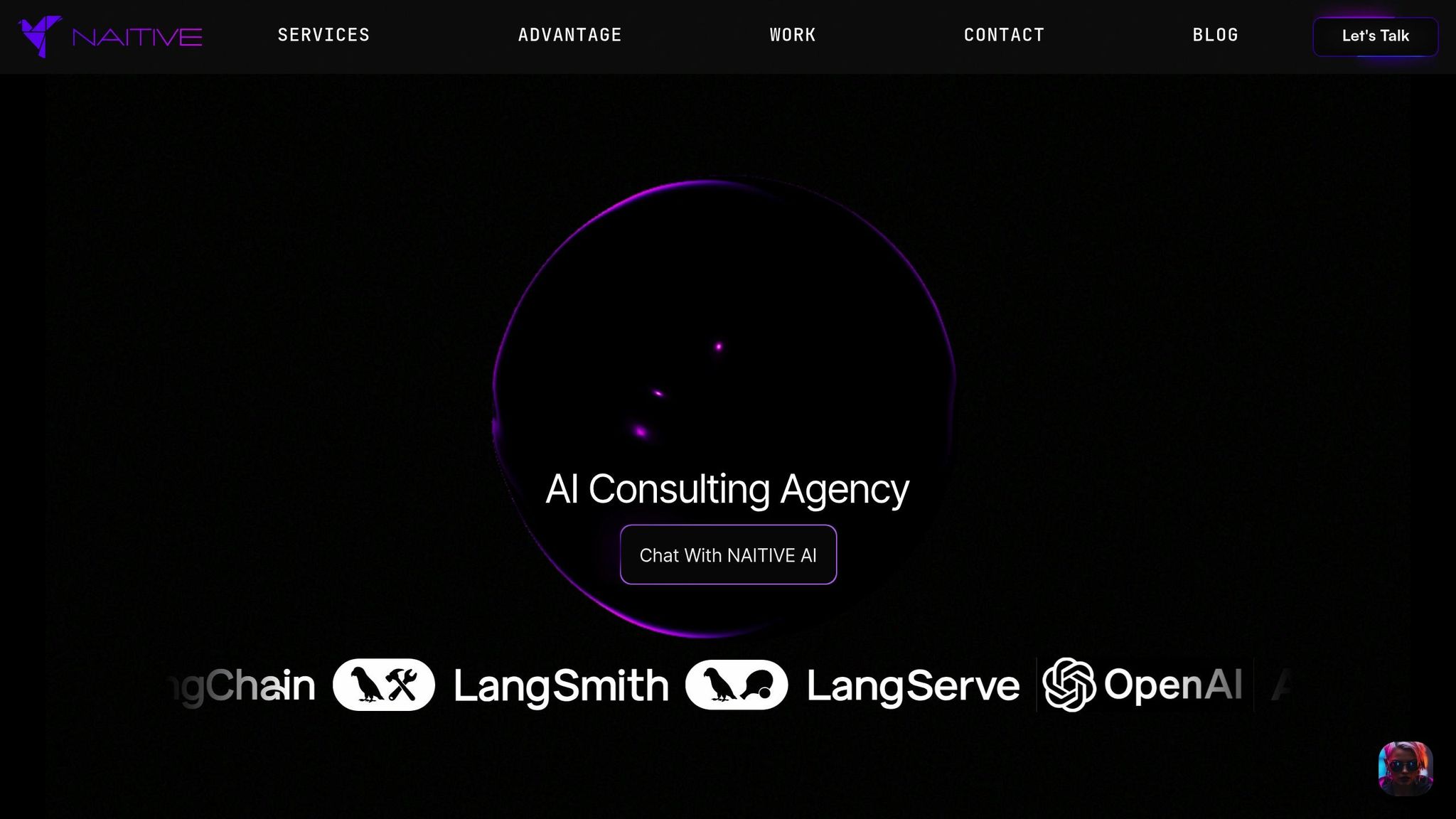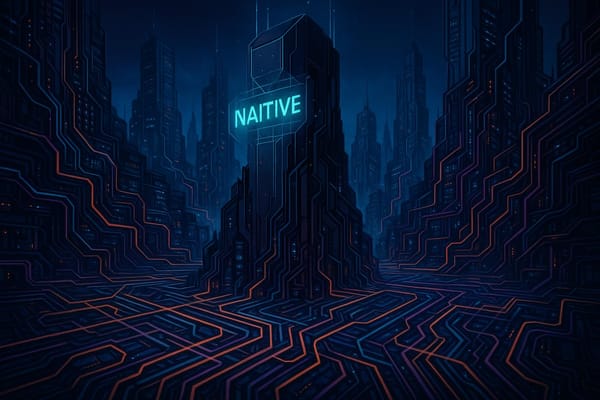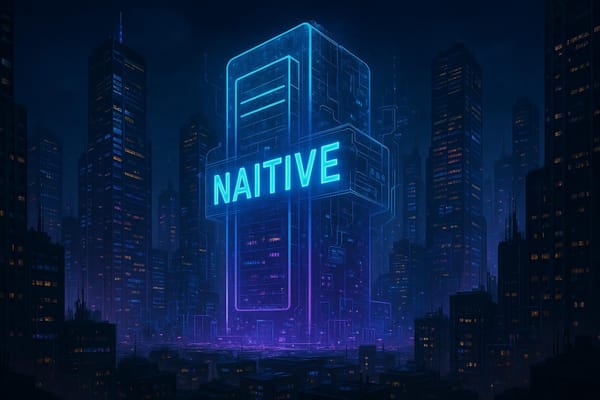Custom AI Models vs. Off-the-Shelf: ROI Breakdown
Explore the trade-offs between custom AI models and off-the-shelf solutions, focusing on ROI, scalability, and long-term business impact.

Custom AI models and off-the-shelf AI solutions each have distinct advantages, and the choice between them often hinges on your business needs, budget, and long-term goals. Here's the key takeaway:
- Custom AI Models: Higher upfront cost but tailored to specific business needs. They offer better long-term ROI, scalability, and ownership of data and systems. Ideal for businesses with unique processes or proprietary data.
- Off-the-Shelf AI Solutions: Lower initial cost and quicker implementation, but limited customization and scalability. Best for businesses needing fast deployment and standard solutions.
Quick Comparison
| Criteria | Custom AI Models | Off-the-Shelf AI Solutions |
|---|---|---|
| Initial Investment | $100,000 - $400,000 | $1,000 - $100,000 |
| Monthly Subscription | None | $99 - $1,500+ |
| Customization | Fully tailored | Limited |
| Scalability | Designed for growth | May face limitations |
| Time to ROI | 2-3 years | Immediate but ongoing costs |
| Data Ownership | Full control | Vendor-dependent |
If your business relies on unique workflows or proprietary data, custom AI offers a better long-term return. For simpler, standardized needs, off-the-shelf solutions may suffice. The right choice depends on aligning the solution with your goals, budget, and technical capabilities.
ROI for Your AI: Budgeting, Costing, and Measuring AI Automation
Custom AI Models: ROI Factors
Custom AI models come with a hefty upfront price tag but deliver personalized benefits that align closely with your business goals. Unlike ready-made solutions, these systems are designed specifically for your needs, offering unique advantages that can directly influence your financial outcomes. However, this kind of investment requires a thorough breakdown of costs to make informed decisions.
Cost Structure of Custom AI Models
The costs of developing a custom AI model typically follow a clear pattern: higher initial expenses are offset by lower long-term operating costs. Breaking down these costs is key to understanding the overall investment.
Here’s how costs generally stack up:
- Data acquisition and preparation: 15–25% of total project costs
- Algorithm development and customization: 20–30%
- Infrastructure expenses: 10–20%
- Integration with existing systems: 15–25%
- Team costs: 40–60% of the total budget
For example, in 2025, a mid-sized financial services company allocated $175,000 for a custom AI fraud detection system. Their spending included 22% for data preparation, 28% for algorithm development, 15% for infrastructure, 18% for integration, and 17% for first-year maintenance costs.
Ongoing maintenance is another critical factor for ROI. Annual updates and maintenance typically range from 15–25% of the initial development cost. A retail company, for instance, initially allocated only 10% for annual maintenance, which led to declining performance after 14 months. When they increased maintenance spending to 22%, they saw a 28% boost in prediction accuracy.
Another cost advantage of custom AI models is the elimination of recurring vendor fees. Unlike off-the-shelf solutions that require ongoing subscriptions, custom systems avoid this added expense once they’re fully deployed.
| Industry | Typical AI Use Cases | Estimated Cost Range (USD) |
|---|---|---|
| Healthcare | Medical imaging, Patient triage, Telemedicine | $60,000 – $250,000+ |
| Finance | Credit scoring, Algorithmic trading, AML detection | $45,000 – $280,000+ |
| Retail & eCommerce | Product recommendations, Demand forecasting | $40,000 – $190,000 |
| Manufacturing | Quality inspection, Predictive maintenance | $40,000 – $170,000 |
| Logistics | Route optimization, Real-time tracking | $35,000 – $160,000 |
By understanding these costs, businesses can better appreciate the competitive edge that custom solutions can provide.
Customization and Competitive Advantage
Beyond cost considerations, custom AI models offer distinct strategic benefits by boosting competitive positioning. These systems are designed to integrate seamlessly with your unique processes, leveraging proprietary data to deliver better outcomes.
Take Walmart, for example. Their custom AI demand forecasting system combined data from point-of-sale transactions, weather patterns, economic trends, and even social media sentiment. This led to a 30% improvement in forecast accuracy, a 20% reduction in stockouts, and a 15% cut in inventory holding costs, generating an annual ROI exceeding $1 billion.
Industry-specific solutions also showcase measurable results. A global manufacturing company invested $650,000 in a predictive maintenance AI system. The results? Unplanned downtime dropped by 37%, maintenance costs fell by 28%, and equipment lifespan extended by 22%. This system paid for itself in just 14 months and delivered a 3.2x return over three years.
Netflix’s custom recommendation engine is another prime example. By analyzing user viewing habits, it delivers personalized content suggestions, which has significantly boosted customer retention and subscription revenue.
Custom AI also streamlines operations. JPMorgan Chase’s COiN system, for instance, reviews legal documents in seconds to identify critical terms, saving millions annually in legal review costs.
Scalability, Flexibility, and Ownership
Custom AI models shine as businesses grow, offering scalability and flexibility that amplify long-term value. Research from Forrester shows that organizations with tailored AI architectures can handle 3.4x growth in data and users before requiring changes. In contrast, off-the-shelf platforms max out at 1.7x growth.
Modular designs also reduce future costs by 32% and speed up implementation by 40%. For example, a transportation company reused modular components across multiple projects, cutting costs and accelerating timelines for subsequent deployments.
Ownership is another major advantage. Custom solutions eliminate vendor dependency, protecting intellectual property and ensuring adaptability. A pharmaceutical company learned this the hard way when their initial off-the-shelf AI system couldn’t scale with growing data volumes. They ended up spending $1.2 million to rebuild it from scratch.
Phased implementation strategies can help manage costs by reducing initial spending by 20–30%. This approach allows businesses to test ROI before fully committing. Over time, these systems often lead to a 30–40% drop in operational costs and a 25% rise in productivity within 18–24 months, with benefits compounding as the system scales.
Off-the-Shelf AI Solutions: ROI Factors
Off-the-shelf AI solutions are often seen as a quick and cost-effective way to adopt artificial intelligence. Unlike custom models, which come with higher upfront costs but tailored functionality, these ready-made options focus on affordability and speed. While they offer immediate financial benefits, they also come with trade-offs that can influence long-term ROI.
Cost Structure and Subscription Models
One of the biggest draws of off-the-shelf AI solutions is their affordability at the outset. Instead of a hefty initial investment, businesses can get started with subscription plans ranging from $99 to $1,500 per month, depending on the features and scale required. This pricing model lowers the entry barrier and spreads costs over time, making it easier for smaller organizations to adopt AI.
However, the long-term picture isn't always as rosy. As a business grows and its AI usage increases, subscription fees can rise sharply. Over time, these escalating costs may outweigh the initial savings. For this reason, it’s crucial to evaluate your expected usage and growth trajectory to fully understand the total cost of ownership.
Ease of Use and Deployment Speed
One of the standout benefits of off-the-shelf AI solutions is how quickly they can be deployed. Unlike custom AI development, which can take months, these platforms are often ready to go within days or weeks. Their user-friendly interfaces mean that even team members with limited technical expertise can start using them with minimal training. This fast implementation not only accelerates ROI but also eliminates the need for extensive onboarding or hiring additional technical staff.
Customization Limits and Vendor Dependency
Despite their advantages, off-the-shelf AI solutions come with some notable drawbacks. These systems are built to cater to a broad audience, which means they lack the flexibility to meet highly specific business needs. Customization options are often limited, making it difficult to adapt the software to unique workflows or evolving requirements. In fact, studies reveal that 70% of businesses investing in AI solutions express dissatisfaction due to the tools falling short of their specialized needs.
Another challenge is vendor dependency. Businesses relying on third-party providers for updates, support, and service continuity are vulnerable to changes in the vendor’s pricing or product roadmap. Many of these solutions are cloud-based, which raises additional concerns about data security and privacy - especially for organizations in regulated industries.
| Criteria | Custom AI Development | Off-the-Shelf AI Solutions |
|---|---|---|
| Customization | Fully tailored to specific needs | Limited customization options |
| Scalability | Scales seamlessly with business growth | May face limitations as needs grow |
| Dependency | Minimal reliance on third-party vendors | High dependency on vendors |
| Opportunity Costs | Enables unique competitive advantages | May limit innovation due to generic features |
Additionally, off-the-shelf solutions often struggle to integrate smoothly with existing enterprise systems. This can lead to extra development work or the creation of data silos, which disrupt workflows and reduce efficiency. As businesses expand and handle larger data volumes or more complex tasks, these scalability issues can become even more problematic.
ROI Comparison: Custom vs. Off-the-Shelf
When it comes to AI investments, custom solutions may require a higher upfront cost, but they often deliver far better returns in the long run. The difference boils down to how costs, timelines, and capabilities influence your business outcomes over time.
Custom-built AI aligns perfectly with your unique processes, cutting out 85–90% of the unnecessary features that off-the-shelf products typically include. Steve Blank put it best:
"We now know that something between 85-90% of most software product features are unwanted by customers. That is an enormous amount of waste of time and money that ends up on the floor."
This waste directly impacts ROI. For instance, a regional healthcare provider spent $1.2 million on a custom solution and saw $3.7 million in operational savings over 18 months, improving resource utilization by 23%. In contrast, a generic system only achieved 7–9% improvements. The table below highlights key differences between custom and off-the-shelf AI solutions.
Comparison Table
| ROI Factor | Custom AI Models | Off-the-Shelf AI Solutions |
|---|---|---|
| Initial Investment | $100,000 - $400,000 | $1,000 - $100,000 |
| Monthly Subscription | None (one-time development) | $99 - $1,500+ (increases with usage) |
| Annual Maintenance | 15-25% of development cost | 22-25% of purchase price |
| Development Timeline | 1-9 months | Immediate implementation |
| Time to ROI | 2-3 years typically | Ongoing costs may exceed savings |
| Feature Utilization | 100% (tailored to needs) | 10-15% (85-90% unused) |
| Scalability Costs | Built-in from the start | Can increase costs by up to 40% |
| Security Risk | 25% lower cyberattack risk | Higher risk as a common target |
| Data Ownership | Full control and ownership | Vendor-dependent |
| Customization Control | Complete flexibility | Limited to vendor options |
| Integration Capability | Seamless with existing systems | May require costly workarounds |
| Performance Gains | 3.5x greater productivity | Standard industry benchmarks |
The numbers tell part of the story, but performance and scalability add even more weight to the argument for custom solutions. McKinsey research shows that businesses using custom AI see an average of 3.5x greater productivity improvements compared to those with generic AI tools. For example, a financial institution that adopted a custom fraud detection system reported a 37% improvement in accuracy over their previous vendor solution.
Custom AI systems are also designed to handle growth more effectively. According to Forrester, companies with tailored AI architectures can support 3.4x more growth in data volume and user base before requiring major changes, compared to just 1.7x growth for off-the-shelf platforms.
Another consideration is the long-term cost trajectory. While off-the-shelf solutions may seem cheaper initially, their cumulative costs can quickly add up. A global manufacturing company that implemented a custom AI solution for predictive maintenance reduced unplanned downtime by 73% compared to their generic system. With unplanned downtime costing over $300,000 per hour, the financial benefits of custom solutions become undeniable.
Custom AI also provides better security. By reducing cyberattack risks by up to 25%, businesses can lower insurance premiums, minimize breach-related costs, and improve compliance. Marcus Chen, Chief Information Security Officer at a Fortune 500 financial services firm, explains:
"The most effective approach to AI security isn't bolting protections onto existing systems, but designing security into the architecture from the beginning. Custom development makes this possible in ways that configured products simply cannot match."
Ultimately, the question isn’t whether AI can deliver returns - it’s about maximizing those returns. Currently, AI investments deliver an average return of 3.5x, with some companies reporting as much as 8x.
Decision Framework for AI Adoption
Investing in AI can feel like navigating a maze, especially when 70% of businesses end up dissatisfied because they choose the wrong solution for their needs. To make the most of your investment and avoid costly missteps, a well-thought-out decision framework is essential.
Choosing between custom-built and off-the-shelf AI isn’t just about the budget - it’s about aligning the solution with your organization’s maturity, strategic goals, and long-term vision. Dr. James Wilson, Director of AI Strategy at a leading technology research firm, puts it this way:
"The most successful organizations match their sourcing strategy to their AI maturity stage. Early-stage initiatives benefit from external expertise to establish foundations, while mature AI programs often thrive with internal teams that deeply understand the business context."
Let’s break down the key factors that can guide your AI sourcing strategy.
Budget and Innovation Goals Assessment
Your budget and innovation goals are the foundation of any AI decision. Off-the-shelf solutions often come with lower upfront costs, typically through subscription models. On the other hand, custom AI solutions require a larger initial investment but can offer better long-term value. Over a three- to five-year period, the benefits of tailored solutions can outweigh the initial costs, especially for businesses with unique processes that drive their competitive edge.
For companies aiming high with innovation, custom AI can deliver significant returns. Studies show that custom software can improve operational efficiency by 20% and increase ROI by 15%. This advantage becomes even more pronounced when your business relies on unique workflows.
As the QAT Editorial Team at QAT Global notes:
"Amplify your competitive edge by aligning software with your unique processes."
When evaluating budgets, consider your funding cycles and cash flow. Off-the-shelf solutions might be appealing for organizations with limited upfront capital. However, if your business depends on proprietary data handling or unique processes, a custom solution could be essential. Once you’ve assessed your financial capacity, the next step is to evaluate your internal technical expertise and scalability needs.
Technical Expertise and Scalability Requirements
Your in-house technical capabilities are a critical factor in deciding between custom and off-the-shelf AI. Custom AI development demands either strong internal expertise or a reliable external partner to handle ongoing maintenance and upgrades. Without this foundation, you risk cost overruns or underperforming systems.
Dr. Elena Markova, Chief Data Scientist at a leading AI consultancy, highlights:
"In our experience implementing enterprise AI systems, organizations that invest in rigorous data preparation typically achieve 40–60% better performance outcomes than those that rush to model development with inadequate data foundations."
Custom AI solutions also offer greater scalability, allowing businesses to grow significantly before needing modifications. This is particularly important for organizations expecting rapid expansion.
A hybrid approach can be a smart middle ground. Start with off-the-shelf solutions to achieve quick wins and validate concepts, then gradually integrate custom components to secure unique advantages. This strategy provides immediate value while building internal expertise over time.
How NAITIVE AI Consulting Agency Supports Decision-Making

Expert guidance can make all the difference when navigating these decisions. NAITIVE AI Consulting Agency specializes in tailoring solutions that align with your technical capabilities and financial goals. Rather than offering a one-size-fits-all approach, NAITIVE starts with a deep dive into your organization’s current capabilities, data infrastructure, and strategic objectives.
Their team helps determine whether your business needs custom development to maintain its competitive edge or if an off-the-shelf solution will suffice. NAITIVE’s expertise spans areas like autonomous AI agents, phone/voice automation, and business process automation - fields where custom development often delivers exceptional returns.
For businesses considering a hybrid approach, NAITIVE identifies which components to customize and which can utilize pre-built solutions. Their process includes a detailed total cost of ownership analysis, factoring in integration, maintenance, and scalability over several years.
NAITIVE also provides ongoing support for implementation and optimization, ensuring your AI investment delivers measurable results. Their focus on outcomes means you can track ROI from day one and refine your strategy as needed.
The QAT Editorial Team emphasizes the importance of collaboration in this process:
"Early collaboration among tech, operations, and leadership teams ensures the solution meets operational and strategic goals."
Conclusion
Deciding between custom AI models and off-the-shelf solutions isn’t just about technology - it’s about aligning with your business strategy and financial goals. Off-the-shelf solutions offer faster deployment and lower upfront costs, making them appealing for companies prioritizing speed. On the other hand, custom AI models provide a deeper edge in competitiveness and better long-term returns, especially for businesses with unique processes.
Here’s the data: In 2023, 91% of companies invested in AI, but only 22% successfully scaled it across multiple business functions. Those that aligned AI investments with clear objectives saw tangible results: 56% reported improved customer satisfaction, 47% achieved product innovation, and 46% reduced costs.
Budget considerations play a major role. While custom solutions require a higher initial investment, they often yield stronger returns over three to five years. Meanwhile, off-the-shelf options are ideal for standardized processes or companies looking for quick wins, though they might limit differentiation in competitive markets.
Technical expertise and scalability are equally critical. Custom AI systems demand either a skilled in-house team or dependable external partners. Without these, even advanced AI systems can fall short or become expensive to maintain. When done right, however, the results can be transformative.
Real-world examples back this up. Strategically implemented AI consistently delivers measurable gains in efficiency and customer service. For instance, NAITIVE AI Consulting Agency has helped businesses navigate these decisions with tailored strategies. One client reported that NAITIVE's Voice AI Agent Solution enabled 200 outbound calls daily, boosting customer retention by 34% and conversions by 41%. Another noted that AI agents now handle 77% of their L1-L2 client support needs.
Looking ahead to 2025, with 89% of executives advancing Gen AI initiatives, companies that make informed, strategic choices about their AI investments will be best positioned for sustained growth. Whether you choose custom development or off-the-shelf solutions, the key lies in aligning your decision with your budget, innovation goals, and long-term vision.
FAQs
How do I decide between a custom AI model and an off-the-shelf AI solution for my business?
When choosing between a custom AI model and an off-the-shelf solution, it's important to weigh your business goals, budget, and long-term priorities.
Custom AI models are designed specifically for your needs, giving you more flexibility, scalability, and control over your data. While they come with a higher upfront cost, they often pay off in the long run by streamlining operations, boosting efficiency, and giving your business a competitive advantage.
Off-the-shelf solutions, however, are more budget-friendly at the start and can be implemented quickly. They're a great fit for businesses with limited budgets, straightforward use cases, or urgent requirements. The downside? They might not adapt well to complex or changing business needs.
When deciding, consider factors like your budget, the complexity of your operations, your data security requirements, and whether you need a solution that can grow alongside your business. Custom models are ideal for businesses aiming for long-term gains, while off-the-shelf options suit simpler, short-term applications.
What are the key advantages of custom AI models over off-the-shelf solutions when it comes to scalability and data ownership?
Custom AI models offer businesses scalability and complete control over their data, creating opportunities that off-the-shelf solutions often can't provide.
These models are built to grow alongside your business. They can manage increasing data loads and adapt to changing operational demands without losing efficiency. In comparison, pre-built solutions might fall short when faced with unique or expanding needs.
Another key advantage is data ownership. With custom AI, your data stays private, secure, and aligned with industry regulations. This control means you can fine-tune your system to your exact requirements, leveraging your data strategically to establish a solid, data-driven approach for ongoing growth.
What are the long-term cost differences between off-the-shelf AI solutions and custom-built AI models?
Off-the-shelf AI solutions are often appealing because they come with lower upfront costs and can be implemented quickly. For businesses seeking a fast setup, this can seem like the perfect choice. However, these solutions can become more expensive over time. Recurring subscription fees, limited ability to scale, and the need for periodic upgrades or replacements can all add up, potentially outweighing the initial savings.
In contrast, custom AI models demand a much larger initial investment - typically anywhere from $20,000 to over $500,000. But this higher cost comes with significant advantages. Custom solutions are built to address specific business needs, which can lead to lower operational costs in the long run. They offer scalability, improve efficiency, and often provide a stronger return on investment (ROI). For companies focused on growth and innovation, the long-term financial benefits of a tailored AI solution can far surpass those of an off-the-shelf option.




